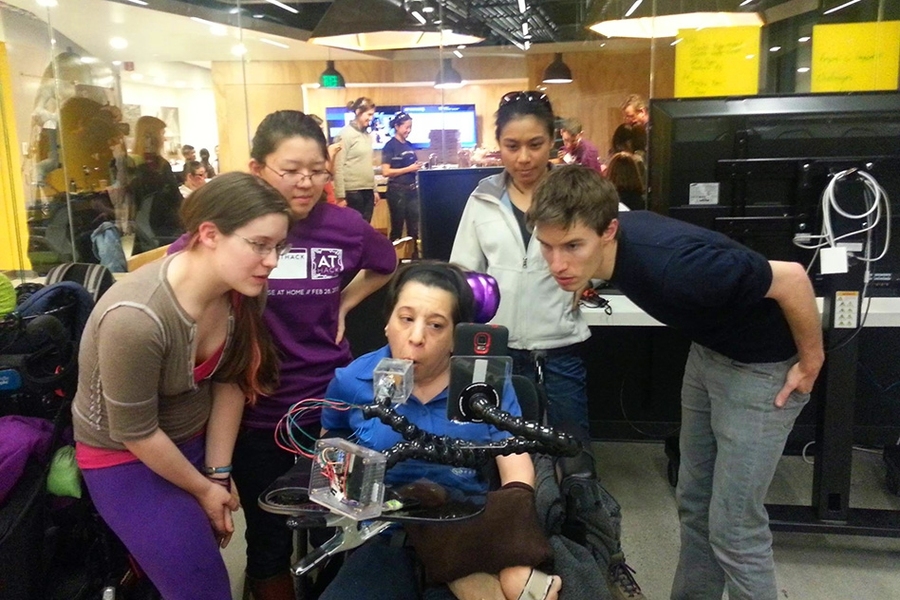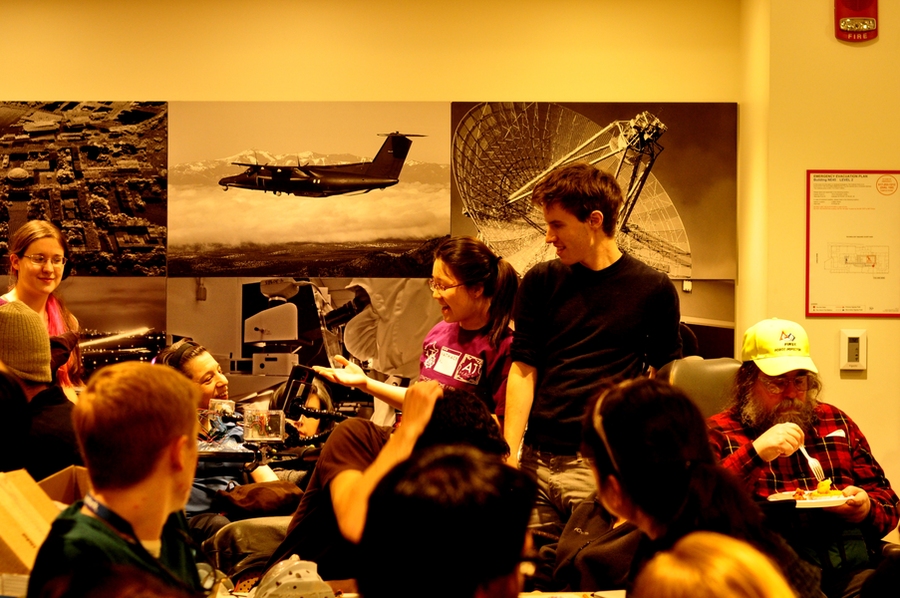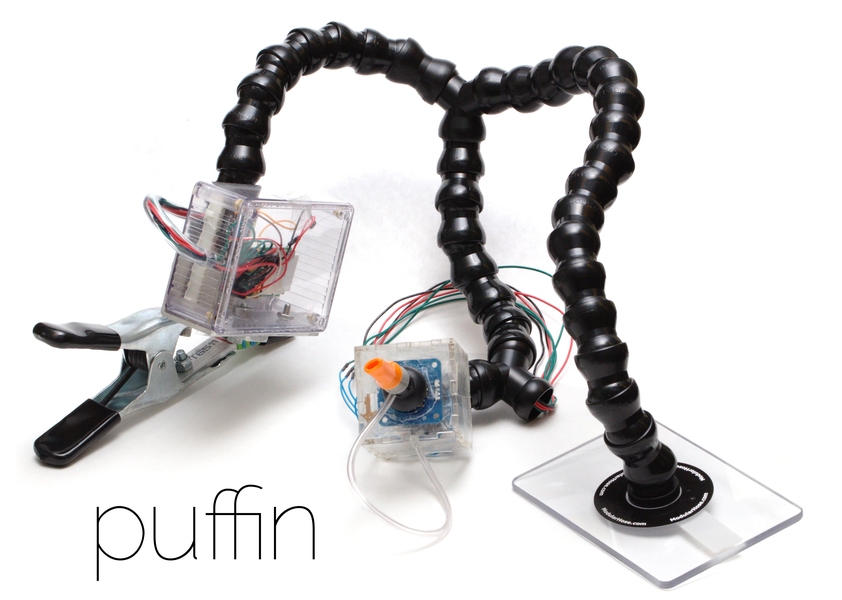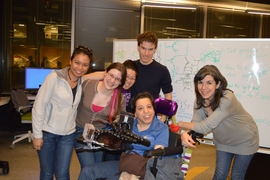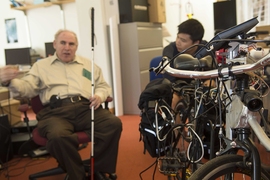It has been nearly four months since 70 MIT undergraduate and graduate students worked in teams at the Assistive Technologies Hackathon (ATHack 2015) to create a prototype improving an aspect in the daily routine of their client, a person living with a disability. ATHack 2015 was dedicated to honor the late Seth Teller, who had inspired MIT students with the class he created in the fall of 2011 titled 6.811 (Principles and Practices in Assistive Technologies), also known as PPAT. Held every fall since, PPAT inspired a group of students to create the ATHack in 2014 as a way to extend this exposure to assistive technologies in the spring term.
The beauty of this event is that in some cases, work initiated during the ATHack does not end there. Here is the story of one team — the winning team — as they continue to bring their prototype to reality.
By day’s end on Feb. 28, at the MIT Lincoln Laboratory Beaver Works in Cambrige, Massachusetts, three teams and their resulting prototypes were announced as winners of the ATHack 2015 top three prizes. Team Adriana — named, as each team traditionally has been, for the first name of their client, Adriana Mallozzi — won first place for the design of what they call “Puffin,” a sip-and-puff joystick controller designed to make it possible for their client — or anyone living with cerebral palsy or without upper body dexterity — to use a smartphone, tablet, or laptop.
Team Adriana members — Ned Burnell, a doctoral student in mechanical engineering; Esther Jang, a grad student in electrical engineering and computer science; Shirlene Liew, a grad student in systems design and management; and Kate Tatar, a mechanical engineering undergraduate — gained their name and assignment at a pre-event dinner held roughly two weeks before the hack. Project ideas had already been worked out in advance by the clients and were then presented by ATHack event directors Ishwarya Ananthabhotla, Jaya Narain, and Abigail Klein. These three were aided by event organizers William Li, Emma Nelson, Sneha Lingam, Jennifer Tylock, Dhruv Jain, and Beth Rosen-Filardo.
Team building and preparation lead to good a hackathon experience
Each team was matched to a client in advance of the hackathon, resulting in 17 teams covering the needs of 14 clients. Several clients were given more than one team to work on multiple assistive technologies. Needs for an assistive technology that were presented to the ATHack teams arose from living with disabilities ranging from cerebral palsy, paraplegia, diabetes, neuropathic facial pain, and hearing and vision impairments.
Jang notes about this pre-event stretch: “A lot of advance preparation happened after the matching.” Her group worked with Mallozzi during the post-dinner week, creating sketches and ideas based on pictures she sent and details about her wheelchair setup. From this work, the team came up with an overall design and the different functional elements they would need: a structural element to hold the mouse, a physical joystick with pressure sensing built in, and a microcontroller plus Bluetooth modules to receive the signals from the joystick and send to the controlled device.
Burnell and his team members were impressed with Mallozzi when, at the dinner as the organizers presented her project and didn’t quite have the details down, she was handed the microphone to provide the description. “Adriana seemed like a great person to work with,” Burnell notes. “When we first approached Adriana, Kate and Esther mostly carried the conversation, while I looked parts up online and asked implementation-specific questions,” he recalls. Within 10 minutes, the group had finalized their materials for the ATHack.
Mallozi says she’s been addicted to technology since age 7, when she was able to use a computer — her first taste of independence, she notes. Living with cerebral palsy from birth, she has been associated since age 1 with Easter Seals, the nonprofit, charitable organization that assists children and adults with disabilities. ATHack 2015 was her first hackathon experience. “I was in heaven that day and was so glad that the team won,” she says, admitting that she is still on a high after the experience.
Design is a conversation
The actual ATHack became an all-out attempt by the team to meet the challenges and snags to complete the things that weren’t planned beforehand. “Though the final prototype was held together with tape and superglue — instead of screws or expoxy,” says Jang, “and a lot of epidermal cells lost in the process — the team won first place.”
Besides the team’s persistence and ingenuity, the real glue was the presence of Mallozzi, who worked by her team all day. Burnell says that Mallozzi helped test things such as the pressure sensor (the threshold for sips and puffs had to be reasonable for her breaths), the length and shape of the joystick mouse, and the positioning of structural elements so that she could use them comfortably. “Her suggestions such as melting the plastic mouthpiece to be a more comfortable shape for her all made the process work,” Burnell explains.
In retrospect, Burnell says his closest experience with client-based design was in high school when he helped people with age-related disabilities configure their computers to be more pleasant and less frustrating to use. He says that it was helpful for Team Adriana members to think out loud about how to do what the client outlined — helping her to communicate what the actual need was. “We don't want to just listen to her and then run away to work on it any more than she wants to be the oracle of what is needed with no input into how it's done,” Burnell noted. “Design is a conversation,” he continued.
Since then, Jang and Burnell, with Mallozzi’s assistance, have applied for small grants around MIT so they can make half a dozen Puffin Joysticks for testing this summer. They have already received an MIT Public Service Center (PSC) LEAP grant for $1,000. There is a good chance that through Easter Seals and Mallozzi’s connections, the Puffin will become known to people who will find it useful — providing real-time testing and application in the ways for which it has been so carefully designed.
